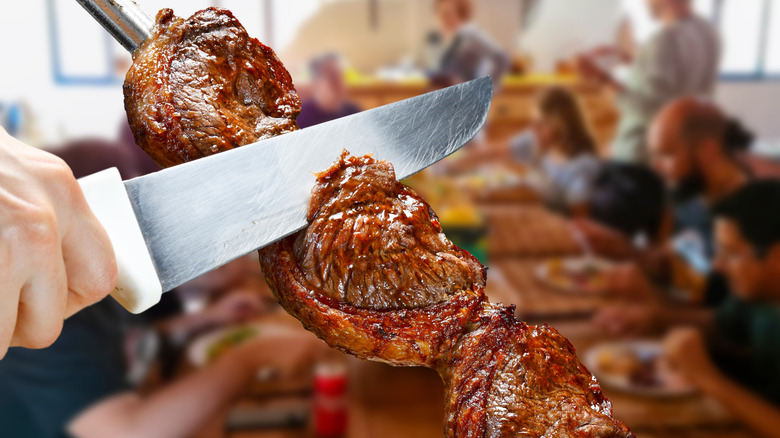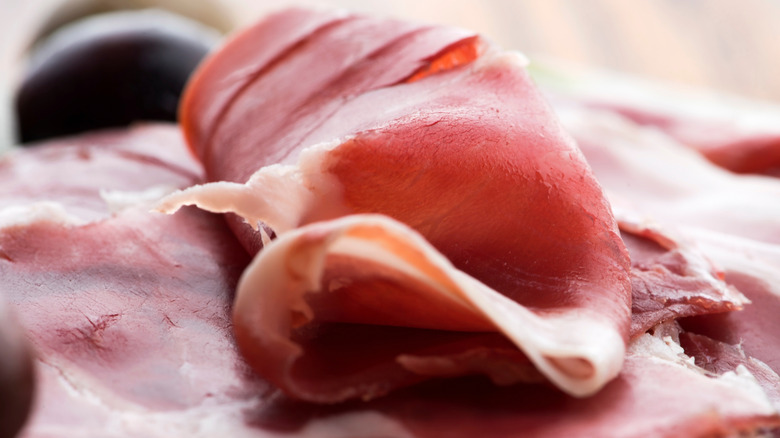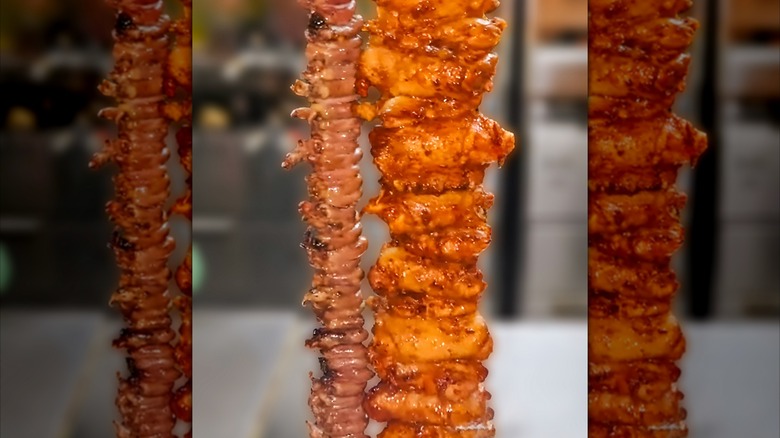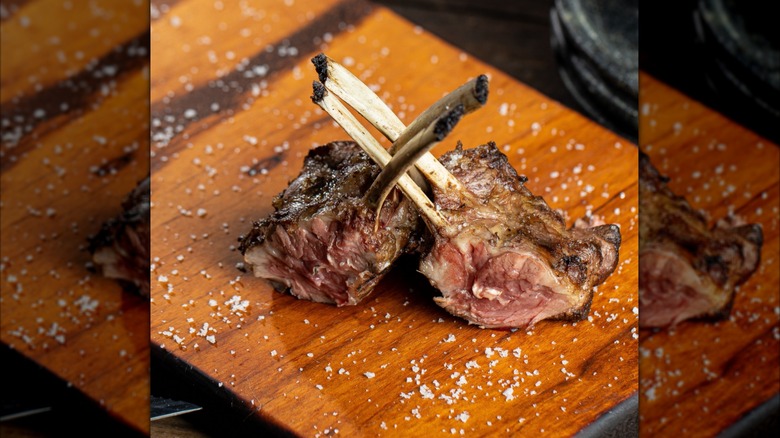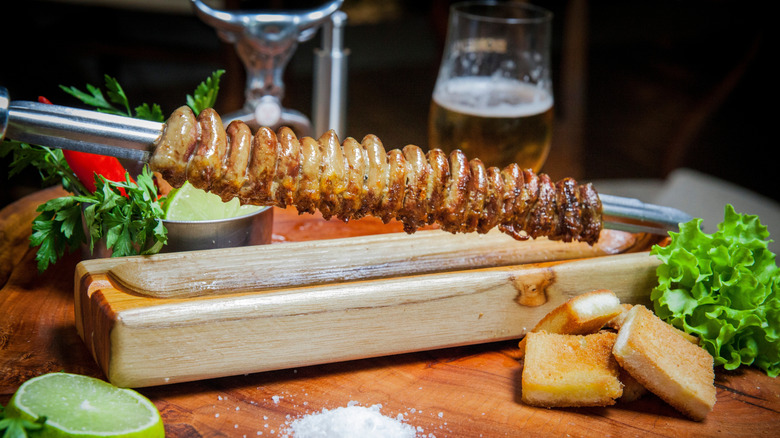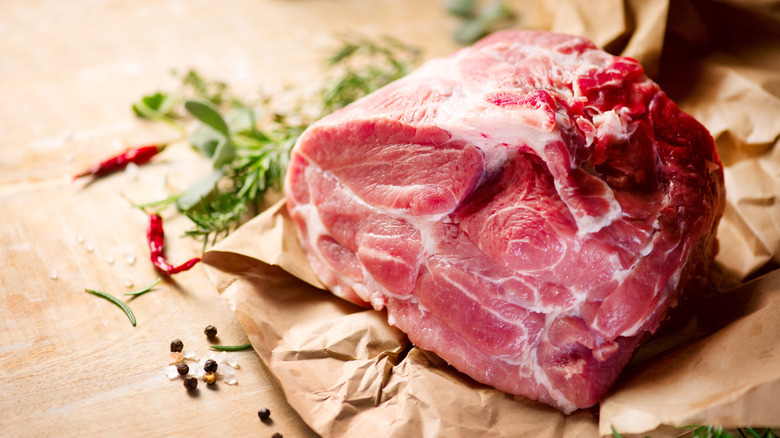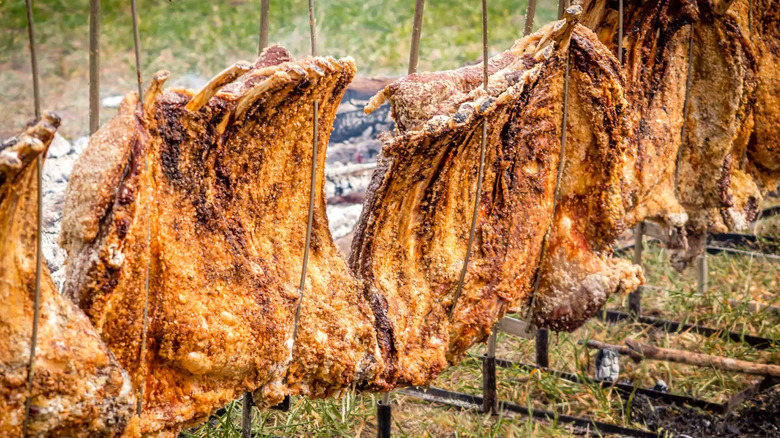Your Complete Guide To Brazilian Steakhouse Meats
Brazilian steakhouses have a lot of different types of food, but it's undeniable that the meat is the star attraction. Over the course of your meal at one of these restaurants, you'll be presented with a never-ending selection of grilled and barbecued beef, lamb, pork, and chicken, which is served fresh and usually sliced tableside. However, one of the main mistakes people make when eating at Brazilian steakhouses is not doing their research about the types of meat they'll be seeing there. This can be a somewhat overwhelming dining style, and one which causes people who aren't in the know to shrink back and make safe choices.
Folks, we're about to put an end to that. Getting your head around meat types at Brazilian steakhouses can be a little confusing, especially if you don't speak Portuguese, but it's not hard. With this handy guide, you'll be able to eat with confidence and find unexpected new favorite cuts of meat. For the uninitiated, Brazilian steakhouses are all about trying new things, and once you've tasted linguiça or coração de frango, you'll never look back.
Picanha
You're likely to see picanha on the menu at any Brazilian steakhouse you dine at. It's arguably the most famous of all the beef cuts served at Brazilian steakhouses, and perhaps the most famous meat full-stop. A massively popular cut of meat in Brazil, picanha is known as the rump cap or sirloin cap in the United States. It's a thick, juicy cut which is crowned with a hefty layer of fat, which keeps the meat lubricated and tender as it cooks.
In Brazilian steakhouses, picanha is generally folded in on itself and piled onto a skewer, giving each piece a curved shape that looks like a crescent, or even large pieces of orecchiette pasta. It's then seasoned and cooked over a churrasco grill, giving it a deep, charred flavor, and then sliced down each side to give every diner a combo of meat and fat. Virtually all the side dishes you'll get at a Brazilian steakhouse go with picanha, given its centrality to the dining style, but it's especially good with garlic mashed potatoes or farofa, which is yuca flour sautéed with bacon and aromatics. You can also slather it with chimichurri.
Lombo
You're likely to encounter a lot of beef at a Brazilian steakhouse, but there is plenty of other meat on the menu too. One of them is lombo, or pork loin. Just like the other meats on offer, lombo is skewered onto large spikes and then fired on a churrasco grill. However, lombo is often given a serious dose of flavor by crusting it with Parmesan cheese, which gives it a slightly paler appearance, contributed to by the lean nature of the meat.
This Parmesan is doing more than just changing the color of the dish, though. It simultaneously gives the meat an umami boost and locks in its moisture. Pork medallions are cut from the loin of the pig and their leanness comes from a lack of intramuscular fat, and they can therefore dry out very quickly. The Parmesan keeps any fat in, and also adds additional fat to the meat, giving it an extra dose of lubrication. It's a great choice if you need a break from all the beef flying around the dining hall, and its smaller chunks make it slightly less intimidating, especially when you're filling up.
Fraldinha
Along with picanha, fraldinha is a cornerstone of Brazilian steakhouses. Fraldinha is a sirloin flap cut which comes from the bottom of the sirloin portion, a part of the cow which has a good amount of marbling. Its name translates to "little diaper," due to the fact that the meat comes from close to the groin. Don't let that put you off, though: This is a highly flavorful cut that retains its moisture excellently when fired on a churrasco.
While picanha has a thick layer of fat above the meat, which drips down and keeps it juicy, fraldinha's marbling allows it to retain intramuscular moisture. As such, it can be charred beyond belief and still remain pretty tender. The passadores at Brazilian steakhouses will typically slice the meat against the grain, so that it remains as easy to bite through as possible. Fraldinha has a robust, meaty flavor, and so chefs generally don't do too much to it. You also won't need to do a lot to it once it's on your plate. This is a beef cut that really shines with a simple chimichurri, thanks to the condiment's ability to cut through the meat's dense flavor with bright, sharp tastes.
Presunto
Presunto is one of the lesser-known meats at Brazilian steakhouses, but we think that makes it a well-kept secret that you should be dying to try. Presunto means ham, but it is often used to refer to a specific lean cut of ham, and it is sometimes referred to as gammon. The churrasqueiros will grill the meat before basting it in a sugary, aromatic glaze.
You may have had ham outside a Brazilian steakhouse, too, since it is also a deli meat, but the two have very different flavors. When it's served as deli meat, it's usually salty, slightly briny, and a little dry, but when cooked in a Brazilian steakhouse, chefs try to bring out its moisture as much as possible. Given the fact that it's not one of those meats that everyone expects at a steakhouse, it can be a little harder to come by. You may also find it in the deli meat section, if the Brazilian steakhouse you're in has a salad bar, like Fogo de Chão's Market Table. If you do find it, pair it with a bright flavor, like a fresh or grilled fruit.
Linguiça
If you've ever seen roving skewers of grilled sausages at a Brazilian steakhouse, there's a chance that it was linguiça. This quintessential Brazilian sausage originated in Portugal, and it's immediately recognizable thanks to its chubby shape and red color, provided by copious amounts of paprika. You're likely to find linguiça in several different forms at Brazilian steakhouses: As well as being a dish on its own, it's also an ingredient in side dishes like feijoada, which you can also make at home.
As well as paprika, linguiça is heavily flavored with garlic and other spices, giving it a punchy and forceful flavor that can dominate the plate. Grilling the sausages brings this flavor out even more, deepening their aroma. Having said this, it's the kind of meat you'll likely want to eat a bit at a time. Linguiça is rich, and if you're not careful, you can fill up on it pretty quickly. Its robust flavor also means that you should think about what you pair it with. Try to go for contrasting taste notes, with creamy or citrus-based side dishes both working well here.
Galeto
Chicken is commonly referred to as frango at Brazilian steakhouses, but if you see galeto, you may find that its flavor is slightly different. That's because galeto refers to a young chicken, typically one that's been marinated overnight in a wine and herb blend. This chicken can be roasted whole or jointed: Some Brazilian steakhouses will serve just the thighs, with the skin crisping up on the grill but the chicken inside remaining juicy. The marinade, meanwhile, gives the chicken an intoxicating aroma and a deep flavor.
Galeto tends to have a slightly milder flavor than other chicken meat, due to the chickens themselves being younger. The chicken pieces may also be a little smaller than you might expect. Like other meats at Brazilian steakhouses, each piece will be stacked in a row along a lengthy skewer. You'll be able to recognize this one by the charred bones along each side. The passadores will usually just fork each piece off instead of slicing strips for you. Although the wine marinade amps up its deeper notes, galeto is a good choice for those who want something light and familiar.
Cordeiro
Beef isn't the only red meat at a Brazilian steakhouse. You'll also likely find plenty of lamb, or cordeiro, on the menu. Cordeiro is the catch-all term for this meat, but the cut that each restaurant uses can differ from place to place. Some restaurants will use leg of lamb or lamb chops, while others will use lamb sirloin. When it's the latter, the lamb will likely be folded into crescent shapes, giving it a similar look to picanha but slightly smaller. Make sure you double-check with your passadore before asking for some to be sliced onto your plate — if you hate lamb, you could be very disappointed.
Cordeiro is cooked over the churrasco in Brazilian steakhouses, giving it a seriously deep flavor while also retaining its juiciness inside. The high heat of the grill allows the lamb to remain rare and succulent. It'll usually be flavored with a herb blend and perhaps a little garlic, but other than salt and pepper there's nothing else added to it, which allows lamb's gamey flavor to shine through. Like beef, it pairs beautifully with chimichurri, and it's also great with a steakhouse wedge salad.
Coração de frango
If you'll excuse the pun, coração de frango is not for the faint-hearted. If you've seen frango on the menu at Brazilian steakhouses before, you'll likely know that this is chicken of some sort. When we tell you that coração translates to "heart," things might fall into place a little more. That's right, people: These are grilled chicken hearts, a specialty you'll find in most Brazilian steakhouses, and a very delicious one at that.
Although chicken hearts, like most organ meats, have a gamey flavor, it's not quite as overpowering as you might expect. Instead, they have a depth to them that remains customizable, as they can be marinated or seasoned, and their bite-sized dimension keeps any flavor from dominating your plate. You'll be able to recognize these in a steakhouse dining room by their size: In contrast to the heaping hunks of picanha and fraldinha, these look like little nubs of meat which have a slight paleness to them. Generally speaking, they won't have a lot of additional flavor added to them, to allow their natural taste to shine through. To take some of the metallic edge off, though, chimichurri and other herb-based side dishes will be your friend.
Pernil de cerdo
If you're lucky enough to find pernil de cerdo on a Brazilian steakhouse menu, nab yourself a slice immediately. Pernil de cerdo translates to pork leg, but it may also be used to indicate pork shoulder or pork butt. You may also find it described simply as "pernil." No matter what it's called or the cut it comes from, though, it'll be a flavorful hunk of roast pork, which develops a serious fall-apart tenderness when cooked for long enough.
Pernil de cerdo will typically develop a crispy layer of crackling on the outside, which gives it an even deeper flavor. The fat will also keep the pork moist, and pernil doesn't tend to suffer from the same dryness issues as other cuts of pork like lombo might. It's best to pair this cut with citrus notes, which help to bring out the lightness of the meat while also cutting through the richness of the crackling and fat. It's also great with a shredded salad or coleslaw, especially those which are dressed more lightly.
Costela
In the mood for ribs? Your Brazilian steakhouse has you covered. Costela is a common cut of meat found in Brazilian steak joints, and they're a little different to the kind you'd order in a barbecue restaurant. Rather than being slathered with a syrupy, unctuous sauce, costela are generally covered in a heady mix of spices and then sprinkled abundantly with salt. They're then slow-cooked on an open grill, with the fire giving them a smoky color and flavor, and the gentler pace providing them with a fall-apart texture. They're then shipped out to the dining room straight away, without any glaze added.
Costela usually refers to beef ribs, but pork ribs are also common in Brazilian steakhouses. They'll sometimes be referred to as costela de porco to distinguish them, and they're cooked in the same way. They also have a similarly deep flavor, although with a touch more lightness than beef and slightly less of a rich note. Whether you're opting for beef or pork ribs, they'll be served just like most meat cuts in a steakhouse: On a large skewer. The passadores will shear off individual ribs and push them onto your plate, ready for you to pick them up and chomp away.
